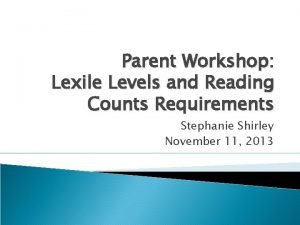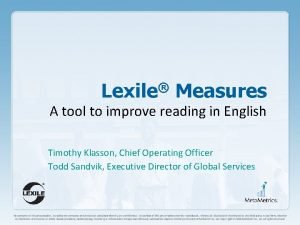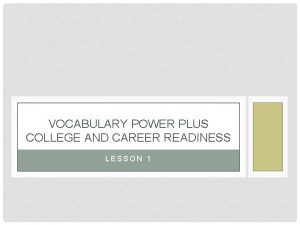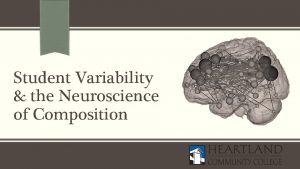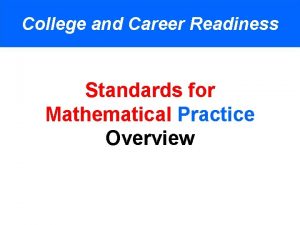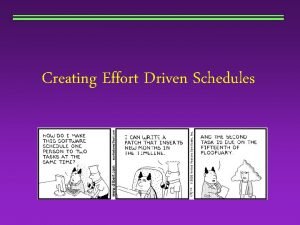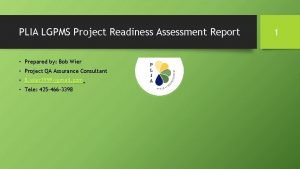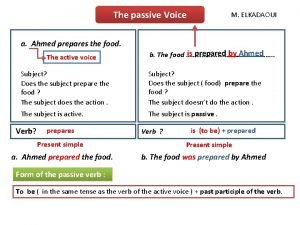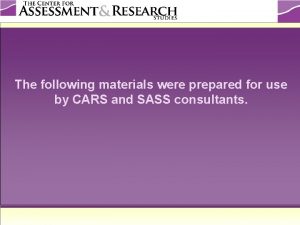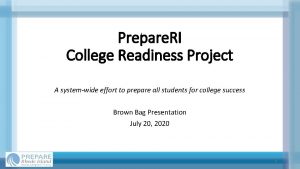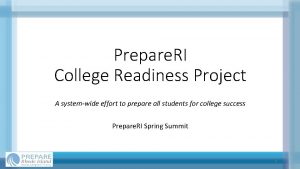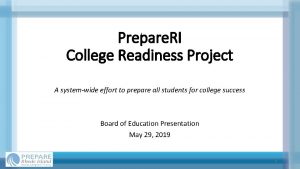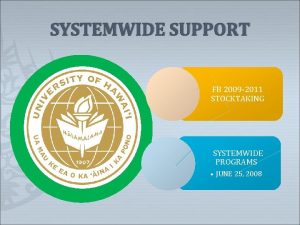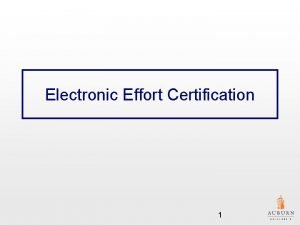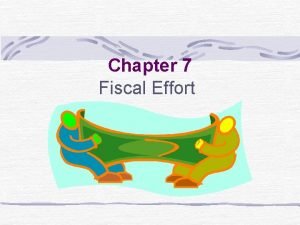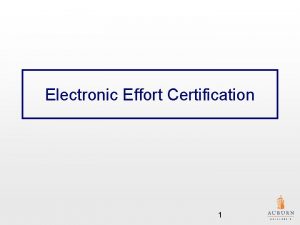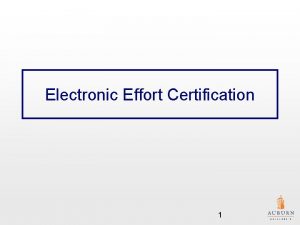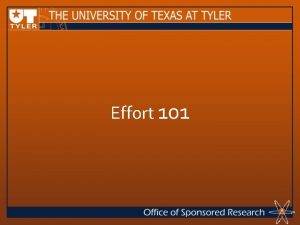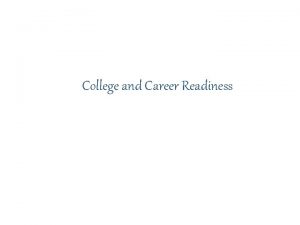Prepare RI College Readiness Project A systemwide effort












- Slides: 12

Prepare. RI College Readiness Project A system-wide effort to prepare all students for college success Prepare. RI Spring Summit Saturday, March 16, 2019 1

Background The Prepare. RI College Readiness Project represents a strategic partnership between K-12 education and Rhode Island’s colleges and universities to ensure that every student graduates from high school ready to enroll in credit-bearing coursework on a path to on-time college completion. 2

Timeline • November 2018: Convened cross-agency leaders • Project “sponsors” (leaders from CCRI, RIC, URI, RIDE, OPC, BOE, and Governor's Office) met on November 2, 2018 to begin collaboration and define the problem • December 2018: Drafted Readiness Project plan • Drafted plan to align statewide efforts • Sponsors met to discuss and approve plan • January through May 2019: Implementation • • Colleges and universities identifying members of working groups Data. Spark analyzing student readiness data OPC leading FAFSA Dash Working groups carrying out the plan 3

Readiness Project goals Category Work stream Goal Readiness 1. Academic readiness (math, reading, and writing) Identify and scale successful models preparing high school students with college preparatory math, reading, and writing skills 2. Alignment of requirements Align high school graduation requirements and postsecondary admission requirements 3. CTE college credit Align statewide career and technical education (CTE) standards in STEM fields with postsecondary requirements and provide college credit. 4. FAFSA Increase statewide FAFSA completion rate to 85%, with every high school above 70% 5. Communication Create and share guide to help families and students navigate the transition from high school to postsecondary 6. Major-aligned college credit Support students in choosing dual/concurrent credits that align to the requirements of their desired college major Matriculation Communication 4

Data: Where are we now? • Research question: • How many students who start at a public high school in Rhode Island earn a postsecondary degree? • Methodology: • Data. Spark, housed at URI, conducted this research using national data and the RI Data. HUB, a statewide longitudinal database including data from RIDE, OPC, and other state agencies • Looked at the cohort of students who started 9 th grade in a RI public high school in 2007 -2008 • Counted any graduation, enrollment, or postsecondary degree earned in the 10 years following 9 th grade (2008 to 2018) • “Postsecondary degree” includes 2 - and 4 -year degrees earned at any accredited private or public institution in the US 5

The pathway of Rhode Island’s 2007 -2008 high school freshman class Each icon represents one student from the 2007 -2008 high school freshman class. This analysis indicates whether those students completed each step at any point in the 10 years from 2008 to 2018. 6

Takeaways from the data 1. Too few RI students complete high school and earn a postsecondary degree • Of 100 students that start 9 th grade, only 34 have earned a postsecondary degree after ten years 2. This completion gap is particularly large for our most vulnerable student populations • Students of color, low-income students, and students with IEPs have significantly lower degree completion rates • While the 10 -year postsecondary degree earning rate is 34% overall, it is 21% for students of color and 9% for students with IEPs 3. Completion is a bigger issue than transition • There is less of a drop-off as students transition from high school to college (-9 percentage points) versus within high school (-19 points) or postsecondary (-38 points) • Areas for future research: • What are the predictors of college success that appear in high school? How can we help students with these predictors before they drop out? • Are there any successful models in Rhode Island that we can expand statewide? • Diving deeper into the data from individual schools, postsecondary institutions, and student populations. (Example: Hispanic students have lower rates of high school graduation but higher rates of postsecondary completion. ) 7

Readiness for Postsecondary Success Institutionally and as a postsecondary system, partner on actions that improve students’ academic and non-academic readiness for postsecondary success • Build on existing efforts system-wide to provide high school students with rigorous, college-level transcripted course experiences. • Dual and concurrent enrollment courses, CS 4 RI, CTE • Explore different approaches and share information to support increased postsecondary success • CCRI’s partnership with Central Falls, analysis of placement exams • Early awareness to support college access, especially for first-generation and underrepresented students • Statewide FAFSA initiative 8

May Deliverables Category Work stream Deliverable for May 2019 Readiness 1. Academic readiness (math, reading, and writing) High schools have information about their remediation rates. RFP released for scaling successful models of high schools reducing remediation rates 2. Alignment of requirements Present proposal for aligning requirements at Board of Education meeting in May 3. CTE college credit Postsecondary institution(s) approve articulation agreements to award college credit for at least one credential in each of the 8 prioritized CTE Board Standards in STEM fields 4. FAFSA Increase statewide FAFSA completion rate to 85%, with every high school above 70%. 5. Communication RIDE publishes family guide for secondary to postsecondary transition. 6. Major-aligned college credit Departmental working groups formed at postsecondary institutions. Matriculation Communication 9

A Conversation with the Provosts Don De. Hayes Sue Pearlmutter Provost and Vice President for Academic Affairs Interim Provost, Vice President, Academic Affairs University of Rhode Island College 10

If you’d like to know more about the Prepare. RI College Readiness Project, please visit: www. prepare-ri. org/readiness or Contact Liz Texeira at: Elizabeth. Texeira@ride. ri. gov 11

Discussion with the Provosts Don De. Hayes Sue Pearlmutter Provost and Vice President for Academic Affairs Interim Provost, Vice President, Academic Affairs University of Rhode Island College 12
 Wake tech admissions
Wake tech admissions College and career readiness lexile chart
College and career readiness lexile chart College and career readiness lexile chart
College and career readiness lexile chart Vocabulary power plus for college and career readiness
Vocabulary power plus for college and career readiness Brain parts
Brain parts College and career readiness standards math
College and career readiness standards math Effort driven in ms project
Effort driven in ms project Project readiness assessment
Project readiness assessment Early college high school at midland college
Early college high school at midland college Prepare thy work without
Prepare thy work without Active and passive chart
Active and passive chart Prepare the following materials
Prepare the following materials How to prepare scheme of work
How to prepare scheme of work

